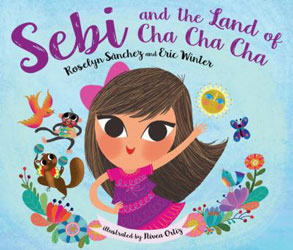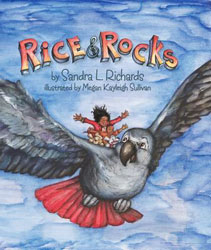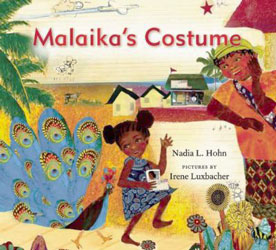Staff Picks for Children

In partnership with

Recommended by Melinda at West Kendall Regional
Sebi and the Land of Cha Cha Cha
By Roselyn Sanchez and Eric Winter, illustrated by Nivea Ortiz

During El Carnaval Latino, Sebi and her friend Keeke are entranced by the colorfully clad dancers doing the cha cha cha. But they barely have time to stumble through a few clumsy steps of their own before a beautiful Cotorra bird catches their eyes and leads them away from the celebration, through the woods and into the Land of Cha Cha Cha. There Sebi and Keeke meet the Cha Cha Cha Cacatua, the Merengue Monkey, and the Samba Squirrels. From these magical creatures they learn several dances: the cha cha cha (from Cuba), the merengue (from the Dominican Republic) and the samba (from Brazil), of course! The lessons end when Sebi and Keeke are called back to the carnaval by Sebi’s mom, with just enough time to show off their new dance routines.
Roselyn Sanchez and Eric Winter have written an ode to the beauty of dance and share simple lessons for the steps highlighted across its pages. Spanish words sprinkled throughout are very easily understood within the context of the surrounding text and illustrations. Nivea Ortiz’s artwork presents characters whose wonder‑filled eyes pull you into the story. The pictures may be two‑dimensional, but the colors and dynamic action give them life. A note from the authors shares information about the dances named in the book.
Check AvailabilityThe Field
By Baptiste Paul, illustrated by Jacqueline Alcántara

Children gather to play soccer in a wide green field in Santa Lucia. They work hard to overcome all the obstacles that stand in the way of their match, clearing the area of goats and cows, building goal posts and staying hopeful in the face of severe weather. But when the rains do come, why let the deluge spoil their fun?
Baptiste Paul’s childhood—when playtime was always outside and as simple as a pickup soccer (or futbol) game—is the sweet inspiration behind this charming tale. When all you needed was friends, a ball and a clear field. He includes words in Creole to drive home the story’s place, and his author’s note and vocabulary sheet on the back cover are not to be missed. Jacqueline Alcántara's bright and detailed illustrations bring life and action to the story. You can almost feel the children running past, the ball soaring through the air and the mud squishing beneath your feet.
Check AvailabilityRice & Rocks
By Sandra L. Richards, illustrated by Megan Kayleigh Sullivan

Every Sunday dinner, Giovanni’s family makes traditional Jamaican jerk chicken with rice and beans. But Giovanni hates “rice and rocks,” as he calls it, and hates it even more this Sunday because he doesn’t want his friends making fun of the meal when they come over for dinner. So his Auntie and Jasper the magical parrot get together to show Giovanni that his friends' traditions include rice and rocks feasts too. After the around the world journey, Giovanni comes back home and is proud to sit at the table with his pals.
Sandra L. Richards writes a story that shows how family traditions are important and shared around the world. Her interconnected stories all share a bird and a meal, tying the kinship themes together. The illustrations by Megan Kayleigh Sullivan are well thought out, giving life to the story. Each color and every line build on each other to tell a story about a shared tradition of rice and beans.
Check AvailabilityMalaika’s Costume
By Nadia L. Hohn, illustrated by Irene Luxbacher

Malaika’s mom has left the island and gone to Canada for work. This will be Malaika’s first Carnival without her, and when the promised money for a new costume doesn’t arrive, she will have to wear an old dress that belongs to her grandma. Malaika doesn’t want to wear a drab hand‑me‑down in the parade and so she runs off in a sad little huff. But after a good long sulk in the village, Malaika discovers a solution—if Grandma will help. And she hopes she does, because Malaika may yet be the very best‑dressed girl at Carnival.
Nadia L. Hohn’s story carries the wonder of the island. Malaika and her grandma are stand‑ins for every family separated by financial need, and watching the little girl grow to understand the necessity of this hardship is a touching journey. Irene Luxbacher imbues each illustration with emotion; her characters are rendered in close‑up detail, making their feelings a strong aspect, while the background can blur. The colors used are lovely and reflect the giddy exuberance of Carnival, and the mixed media lined‑paper background of the text gives the book a personal feel. Be sure to check out the vocabulary list at the front!
Check AvailabilityMama’s Nightingale: A Story of Immigration and Separation
By Edwidge Danticat, illustrated by Leslie Staub

Saya tells the story of how much she misses her mom, who has been sent away to Sunshine Correctional because she doesn’t have the right papers. Every night, Saya’s dad writes letters for help to get her mom out, to get her the proper papers, but never gets an answer. Each week they visit Saya’s mom, but it is always hard to leave her. One day, Saya’s mom starts sending home recordings of bedtime stories, including one about a lost mommy nightingale trying to find a rainbow trail home to her baby. Saya writes letters about her mom too, and finally, someone begins to listen. With the help of the news people, Saya’s mom gets a hearing and may be able to come home. Is this their rainbow?
In her author’s note, Edwidge Danticat writes about how Saya’s story is familiar to the almost 70,000 parents separated from their American‑born children due to not having the right papers. She also writes about how she was torn away from her own parents because of a similar situation. Danticat uses Saya’s story to give voice to all of these families. Leslie Staub breathes life into the story with colorful illustrations; particularly compelling is the extraordinary artwork depicting the dream sequence that reunites Saya and her mother.
Check Availability